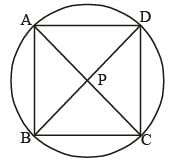SSC CGL Exam > SSC CGL Questions > The diagonals AC and BD of a cyclic quadrilat...
Start Learning for Free
The diagonals AC and BD of a cyclic quadrilateral ABCD intersect each other at the point P. Then, it is always true that (SSC CGL 1st Sit. 2013)
- a)AP . BP = CP . DP
- b)AP . CD = AB . CP
- c)BP. AB = CD. CP
- d)AP . CP = BP . DP
Correct answer is option 'D'. Can you explain this answer?
Verified Answer
The diagonals AC and BD of a cyclic quadrilateral ABCD intersect each ...

Here, AC and BD are chords of the circle.
∴ AP . CP = BP . DP
Most Upvoted Answer
The diagonals AC and BD of a cyclic quadrilateral ABCD intersect each ...

Here, AC and BD are chords of the circle.
∴ AP . CP = BP . DP
Free Test
FREE
| Start Free Test |
Community Answer
The diagonals AC and BD of a cyclic quadrilateral ABCD intersect each ...
Explanation:
Given, ABCD is a cyclic quadrilateral. This means that all four vertices of the quadrilateral lie on a circle.
Property 1: In a cyclic quadrilateral, opposite angles are supplementary.
In quadrilateral ABCD, angle A + angle C = 180 degrees and angle B + angle D = 180 degrees.
Property 2: In a cyclic quadrilateral, opposite angles are equal.
In quadrilateral ABCD, angle A = angle C and angle B = angle D.
Property 3: The opposite sides of a cyclic quadrilateral are in the same ratio.
In quadrilateral ABCD, AB/CD = BC/DA.
Property 4: The opposite angles of a cyclic quadrilateral are in the same ratio.
In quadrilateral ABCD, angle A/angle C = angle B/angle D.
Proof:
To prove that AP.CP = BP.DP, we will use the properties of cyclic quadrilaterals.
Step 1: Extend AP and CP to meet the circumcircle of ABCD at points E and F, respectively.
(Fig 1: AP and CP extended)
Step 2: Since ABCD is a cyclic quadrilateral, angle A = angle C and angle B = angle D.
(Fig 2: Angle equality)
Step 3: In triangle APE, angle A = angle C (opposite angles of a cyclic quadrilateral).
Therefore, triangle APE is an isosceles triangle, and AE = PE.
Similarly, in triangle CPF, angle B = angle D (opposite angles of a cyclic quadrilateral).
Therefore, triangle CPF is an isosceles triangle, and CF = PF.
(Fig 3: Isosceles triangles)
Step 4: Applying property 3, we have AB/CD = BC/DA.
Dividing both sides by BC, we get AB/BC = CD/DA.
Using the property of similar triangles (APE and BPC are similar), we have AP/BP = AE/CF.
Similarly, using the property of similar triangles (CPF and DPA are similar), we have DP/CP = PF/CF.
Step 5: Combining the above two equations, we get AP/BP * DP/CP = AE/CF * PF/CF.
Simplifying further, we get AP.BP/CP.DP = AE.PF/CF.CF.
Since AE = PE and CF = PF, we have AP.BP/CP.DP = PE.PF/CF^2.
But PE.PF = PA.PB (product of lengths of tangents from a point to a circle).
Therefore, we have AP.BP/CP.DP = PA.PB/CF^2.
Step 6: In triangle CPF, angle B = angle D (opposite angles of a cyclic quadrilateral).
Therefore, triangle CPF is an isosceles triangle, and CF = PF.
Using the property of similar triangles (APE and BPC are similar), we have AP/BP = AE/CF.
Therefore, AP.BP = AE.CF.
Step 7:
Given, ABCD is a cyclic quadrilateral. This means that all four vertices of the quadrilateral lie on a circle.
Property 1: In a cyclic quadrilateral, opposite angles are supplementary.
In quadrilateral ABCD, angle A + angle C = 180 degrees and angle B + angle D = 180 degrees.
Property 2: In a cyclic quadrilateral, opposite angles are equal.
In quadrilateral ABCD, angle A = angle C and angle B = angle D.
Property 3: The opposite sides of a cyclic quadrilateral are in the same ratio.
In quadrilateral ABCD, AB/CD = BC/DA.
Property 4: The opposite angles of a cyclic quadrilateral are in the same ratio.
In quadrilateral ABCD, angle A/angle C = angle B/angle D.
Proof:
To prove that AP.CP = BP.DP, we will use the properties of cyclic quadrilaterals.
Step 1: Extend AP and CP to meet the circumcircle of ABCD at points E and F, respectively.
(Fig 1: AP and CP extended)
Step 2: Since ABCD is a cyclic quadrilateral, angle A = angle C and angle B = angle D.
(Fig 2: Angle equality)
Step 3: In triangle APE, angle A = angle C (opposite angles of a cyclic quadrilateral).
Therefore, triangle APE is an isosceles triangle, and AE = PE.
Similarly, in triangle CPF, angle B = angle D (opposite angles of a cyclic quadrilateral).
Therefore, triangle CPF is an isosceles triangle, and CF = PF.
(Fig 3: Isosceles triangles)
Step 4: Applying property 3, we have AB/CD = BC/DA.
Dividing both sides by BC, we get AB/BC = CD/DA.
Using the property of similar triangles (APE and BPC are similar), we have AP/BP = AE/CF.
Similarly, using the property of similar triangles (CPF and DPA are similar), we have DP/CP = PF/CF.
Step 5: Combining the above two equations, we get AP/BP * DP/CP = AE/CF * PF/CF.
Simplifying further, we get AP.BP/CP.DP = AE.PF/CF.CF.
Since AE = PE and CF = PF, we have AP.BP/CP.DP = PE.PF/CF^2.
But PE.PF = PA.PB (product of lengths of tangents from a point to a circle).
Therefore, we have AP.BP/CP.DP = PA.PB/CF^2.
Step 6: In triangle CPF, angle B = angle D (opposite angles of a cyclic quadrilateral).
Therefore, triangle CPF is an isosceles triangle, and CF = PF.
Using the property of similar triangles (APE and BPC are similar), we have AP/BP = AE/CF.
Therefore, AP.BP = AE.CF.
Step 7:

|
Explore Courses for SSC CGL exam
|

|
Question Description
The diagonals AC and BD of a cyclic quadrilateral ABCD intersect each other at the point P. Then, it is always true that (SSC CGL 1st Sit. 2013)a)AP . BP = CP . DPb)AP . CD = AB . CPc)BP. AB = CD. CPd)AP . CP = BP . DPCorrect answer is option 'D'. Can you explain this answer? for SSC CGL 2025 is part of SSC CGL preparation. The Question and answers have been prepared according to the SSC CGL exam syllabus. Information about The diagonals AC and BD of a cyclic quadrilateral ABCD intersect each other at the point P. Then, it is always true that (SSC CGL 1st Sit. 2013)a)AP . BP = CP . DPb)AP . CD = AB . CPc)BP. AB = CD. CPd)AP . CP = BP . DPCorrect answer is option 'D'. Can you explain this answer? covers all topics & solutions for SSC CGL 2025 Exam. Find important definitions, questions, meanings, examples, exercises and tests below for The diagonals AC and BD of a cyclic quadrilateral ABCD intersect each other at the point P. Then, it is always true that (SSC CGL 1st Sit. 2013)a)AP . BP = CP . DPb)AP . CD = AB . CPc)BP. AB = CD. CPd)AP . CP = BP . DPCorrect answer is option 'D'. Can you explain this answer?.
The diagonals AC and BD of a cyclic quadrilateral ABCD intersect each other at the point P. Then, it is always true that (SSC CGL 1st Sit. 2013)a)AP . BP = CP . DPb)AP . CD = AB . CPc)BP. AB = CD. CPd)AP . CP = BP . DPCorrect answer is option 'D'. Can you explain this answer? for SSC CGL 2025 is part of SSC CGL preparation. The Question and answers have been prepared according to the SSC CGL exam syllabus. Information about The diagonals AC and BD of a cyclic quadrilateral ABCD intersect each other at the point P. Then, it is always true that (SSC CGL 1st Sit. 2013)a)AP . BP = CP . DPb)AP . CD = AB . CPc)BP. AB = CD. CPd)AP . CP = BP . DPCorrect answer is option 'D'. Can you explain this answer? covers all topics & solutions for SSC CGL 2025 Exam. Find important definitions, questions, meanings, examples, exercises and tests below for The diagonals AC and BD of a cyclic quadrilateral ABCD intersect each other at the point P. Then, it is always true that (SSC CGL 1st Sit. 2013)a)AP . BP = CP . DPb)AP . CD = AB . CPc)BP. AB = CD. CPd)AP . CP = BP . DPCorrect answer is option 'D'. Can you explain this answer?.
Solutions for The diagonals AC and BD of a cyclic quadrilateral ABCD intersect each other at the point P. Then, it is always true that (SSC CGL 1st Sit. 2013)a)AP . BP = CP . DPb)AP . CD = AB . CPc)BP. AB = CD. CPd)AP . CP = BP . DPCorrect answer is option 'D'. Can you explain this answer? in English & in Hindi are available as part of our courses for SSC CGL.
Download more important topics, notes, lectures and mock test series for SSC CGL Exam by signing up for free.
Here you can find the meaning of The diagonals AC and BD of a cyclic quadrilateral ABCD intersect each other at the point P. Then, it is always true that (SSC CGL 1st Sit. 2013)a)AP . BP = CP . DPb)AP . CD = AB . CPc)BP. AB = CD. CPd)AP . CP = BP . DPCorrect answer is option 'D'. Can you explain this answer? defined & explained in the simplest way possible. Besides giving the explanation of
The diagonals AC and BD of a cyclic quadrilateral ABCD intersect each other at the point P. Then, it is always true that (SSC CGL 1st Sit. 2013)a)AP . BP = CP . DPb)AP . CD = AB . CPc)BP. AB = CD. CPd)AP . CP = BP . DPCorrect answer is option 'D'. Can you explain this answer?, a detailed solution for The diagonals AC and BD of a cyclic quadrilateral ABCD intersect each other at the point P. Then, it is always true that (SSC CGL 1st Sit. 2013)a)AP . BP = CP . DPb)AP . CD = AB . CPc)BP. AB = CD. CPd)AP . CP = BP . DPCorrect answer is option 'D'. Can you explain this answer? has been provided alongside types of The diagonals AC and BD of a cyclic quadrilateral ABCD intersect each other at the point P. Then, it is always true that (SSC CGL 1st Sit. 2013)a)AP . BP = CP . DPb)AP . CD = AB . CPc)BP. AB = CD. CPd)AP . CP = BP . DPCorrect answer is option 'D'. Can you explain this answer? theory, EduRev gives you an
ample number of questions to practice The diagonals AC and BD of a cyclic quadrilateral ABCD intersect each other at the point P. Then, it is always true that (SSC CGL 1st Sit. 2013)a)AP . BP = CP . DPb)AP . CD = AB . CPc)BP. AB = CD. CPd)AP . CP = BP . DPCorrect answer is option 'D'. Can you explain this answer? tests, examples and also practice SSC CGL tests.

|
Explore Courses for SSC CGL exam
|

|
Signup for Free!
Signup to see your scores go up within 7 days! Learn & Practice with 1000+ FREE Notes, Videos & Tests.


















